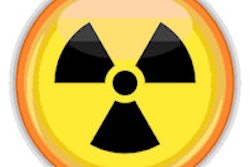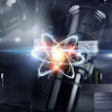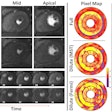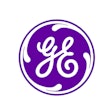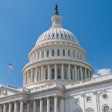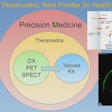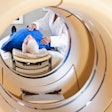A lack of demonstrated harms combined with significant recent dose reductions have led at least one group of cardiovascular imaging specialists to worry less about the risks of a heart scan and more about the well-being of the patient, according to a new review article in Circulation.
In their summary of cardiovascular imaging radiation risks, Dr. Felix Meinel, from the Medical University of South Carolina, and colleagues concluded that the harms of cardiovascular imaging have been overemphasized versus the benefits, especially considering that the average heart scan patient is older than 50, a group for which studies have revealed no obvious risks of imaging.
As part of the equation, any real risks from cardiovascular scans "have to be weighed against the risks of missing or delaying the diagnosis of such conditions or inaccurately assessing their distribution or severity," wrote Meinel and co-authors including Dr. John Nance Jr. and Dr. U. Joseph Schoepf (Circulation, July 29, 2014, Vol. 130:5, pp. 442-445).
"Current estimates of radiation risks from diagnostic imaging tests are chiefly based on extrapolations derived from the increased cancer incidence observed in atomic blast survivors," Meinel wrote in an email to AuntMinnie.com. "As such, these risk estimates have a substantial margin of error."
The linear no-threshold model is a plausible way to derive such risk estimates, and assuming it's correct, "there is probably a real stochastic risk of developing cancer from the radiation received at diagnostic imaging," he said. "However, this risk is small and generally worth taking."
"If there is an appropriate clinical indication, the benefit of imaging tests in guiding treatment almost certainly outweighs the risk," Meinel said. "This consideration particularly applies to patients with known or suspected cardiovascular disease."
Even in young patients, the risk of death from underlying morbidity is more than an order of magnitude greater than the risk of death from long-term radiation-induced cancer, the authors noted.
Sensationalistic stories
Meanwhile, stories about the dangers of radiation in cardiovascular imaging exams have been disseminated widely in the lay press, often in a sensationalistic manner, Meinel and colleagues wrote. The danger is that sometimes they cause patients to forego needed exams.
The authors recounted the story of a 62-year-old retired account executive who complained of diffuse chest pain during moderate activity. His hypercholesterolemia and hypertension were well-controlled, but on a treadmill he quickly tired at a heart rate of 140 beats per minute.
But the patient declined a pharmacological stress radionuclide study, telling the physician that his wife read a magazine article claiming that imaging tests "cause cancer," the authors wrote.
"These publications have received widespread dissemination in the lay media, often in a sensationalist manner, so medical professionals are increasingly confronted by the above patient scenario and its many variations," Meinel and colleagues wrote. "Public concerns have prompted the U.S. Food and Drug Administration to devote considerable attention to radiation protection, and some states have mandated reporting of radiation doses from imaging examinations."
The authors' review sorts through the evidence on stochastic risks from diagnostic cardiovascular imaging tests to offer a realistic summary of the risks involved and enable a rational dialogue between providers and patients, they wrote.
No direct evidence of harm
Direct evidence of a link between radiation from imaging exams and cancer induction is "exceedingly scarce," Mendel and colleagues wrote, noting that the best evidence of harm comes from two large studies recently conducted in pediatric populations.
Based on 10 years of following up 178,000 children and 680,000 adolescents, the studies reported an incremental risk of two to six excess cancers per 10,000 pediatric patients from CT scans.
"Direct evidence of an association between radiation from medical imaging and cancer induction in a general adult population does not exist," they wrote. "Much larger cohorts would likely have to be analyzed to detect any incremental increases in cancer rates because [approximately] 38% of women and 44% of men in the U.S. will develop cancer during their lifetime."
Far more common than epidemiological studies are those that extrapolate down estimated risks to low levels of radiation and multiply these risks across large populations, the authors noted. Studies of atomic bomb survivors in Hiroshima and Nagasaki fall into this category and are detailed in the Biological Effects of Ionizing Radiation (BEIR) VII report.
Such studies have shown a statistically significant increase in cancer in people exposed to 100 mSv or greater radiation doses, and investigators have extrapolated this dose downward to arrive at risk calculations for much smaller doses based on the linear no-threshold theory. But does this work?
"The extrapolation of radiation risks to such low levels of radiation is problematic and subject to substantial uncertainties," Meinel and colleagues wrote. Allowing that the linear no-threshold theory might be a reasonable point to start from, they cautioned that "it remains uncertain whether this model accurately reflects the biological effect of low-level radiation and is suitable for prediction of cancer risks from medical imaging."
Comparing cardiovascular imaging tests to background radiation provides a useful measuring stick for patients and providers alike. The following table shows the average radiation among the various scan options.
| Cardiovascular imaging effective radiation doses | |
| Radiation source | Mean mSv |
| Background radiation in the U.S. | 3 |
| Diagnostic cardiac catheterization | 7 |
| Percutaneous coronary intervention | 17 |
| Cardiac CT angiography, retrospective gating | 12 |
| Cardiac CT angiography, prospective gating | 3 |
| CT pulmonary angiography | 4 |
| Dual-isotope thallium-201/technetium-99m | 22 |
| Rest-stress technetium-99m | 11 |
| Rest thallium-201 | 11 |
| Low-dose technetium-99m stress | 3 |
| F-18 FDG PET | 5 |
In general, dose reductions have been substantial in recent years. The average dose for coronary CT angiography has fallen from between 10 mSv and 20 mSv to about 3 mSv, largely from trimming the acquisition to limited cardiac phases. Similarly, pulmonary embolism CT has slipped from 15 mSv to between 2 mSv and 5 mSv, largely due to the use of automated exposure control to adapt radiation output to the varying thickness of the anatomy, the authors wrote.
In nuclear medicine, low-dose stress-only SPECT is diagnostic at about 3 mSv -- a fraction of the roughly 22 mSv from a classic rest-stress dual-isotope exam of yore, according to Meinel and colleagues. Even FDG-PET has fallen from 14 mSv to 5 mSv, due to factors such as weight-based radiotracer dosing and more-sensitive gamma cameras.
"Recent technologic developments allow for substantial decreases in the radiation dose associated with many cardiovascular imaging tests," Meinel wrote in his email. "These dose-lowering techniques should be consistently applied to further minimize the risk."
When estimating risk, it's also important to weigh both the characteristics of the patient population and the spectrum of cardiovascular diseases, the authors wrote. In most cases, this is where risk really drops, because most imaging is performed in patients ages 50 or older who are less sensitive than younger patients to the effects of radiation.
And what abnormalities are cardiovascular imaging tests looking for? "Suspected or known coronary, cerebrovascular, or peripheral artery disease, pulmonary embolism, and aortic pathologies, all disorders with substantial morbidity and mortality, are among the most common indications for cardiovascular imaging tests," they wrote.
Meinel and colleagues also cautioned that not performing a test can put a patient at substantial risk by withholding its clinical benefits. Also, the stochastic risks of radiation can span decades, whereas suspected cardiovascular disease can pose an imminent threat to the patient.
Even at the highest levels of risk for developing a later malignancy, say one in 2,000, the risk is far outweighed by other hazards of everyday life, such as drowning (one in 1,112), dying in a pedestrian accident (one in 749), or dying in a motor vehicle accident (one in 128), the authors wrote. Yet no one stops walking because of the risk of being hit by a car, for example.
The American Association of Physicists in Medicine (AAPM) and the Health Physics Society (HPS) estimate that the risks of medical imaging at doses of less than 50 mSv for single procedures or 100 mSv for multiple procedures are "too low to be epidemiologically detectable and [are] potentially nonexistent," the authors wrote.
Because risk levels are uncertain, it is reasonable to assume that there is risk in cardiovascular imaging, and every effort should be made to keep doses as low as possible without compromising the benefits of an exam. However, "fear of radiation should not prevent a patient from undergoing a medically necessary imaging examination," Meinel and colleagues concluded.
"Radiologists are the stewards of radiation, and thus it falls to us to educate the public and our colleagues about radiation matters," Schoepf told AuntMinnie.com. "Accordingly, we must own this discussion and take it into a forum that is readily accessible to our referring physicians -- hence our choice of the clinical journal Circulation as a conduit for our message, which is widely read by our target audience. Thus we aim at providing balanced, evidence-based information in a time when the discussion about radiation is increasingly lopsided, biased, and sensationalist."






